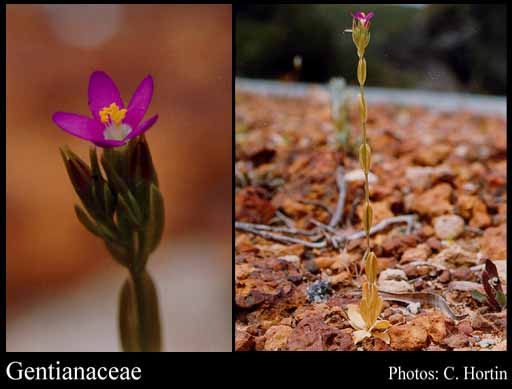- Reference
- Gen.Pl. [Jussieu] 141 (1789)
- Name Status
- Current

Scientific Description
Common name. Gentian Family.
Habit and leaf form. Herbs (mostly, often with dichotomous branching), or herbaceous climbers, or shrubs (a few). Leaves well developed, or much reduced. Autotrophic, or saprophytic. Annual, or biennial; plants with a basal concentration of leaves, or with neither basal nor terminal concentrations of leaves. Climbing (Crawfurdia ~ Gentiana p.p.), or self supporting (usually). Helophytic, or mesophytic (often alpine). Leaves opposite (and decussate, usually), or whorled (rarely — Swertia), or alternate (seldom); rarely (i.e. when alternate) spiral; ‘herbaceous’, or membranous (in mycotrophic species); petiolate to sessile; connate (often), or not connate (but then often connected by a transverse line); simple; epulvinate. Leaf blades entire; pinnately veined, or palmately veined. Leaves without stipules (but the opposing leaf bases sometimes connected by a transverse line). Leaf blade margins usually entire. Leaves without a persistent basal meristem. Stem anatomy. Nodes unilacunar, or tri-lacunar, or multilacunar. Secondary thickening developing from a conventional cambial ring, or anomalous (Gentianoideae); from a single cambial ring.
Reproductive type, pollination. Fertile flowers hermaphrodite, or hermaphrodite, functionally male, and functionally female. Unisexual flowers present, or absent. Plants hermaphrodite (usually), or polygamomonoecious (rarely). Plants homostylous, or heterostylous. Entomophilous.
Inflorescence and flower features. Flowers solitary, or aggregated in ‘inflorescences’; in cymes. The terminal inflorescence unit (when flowers aggregated) nearly always cymose. Inflorescences terminal, or axillary; usually a simple or compound dichasium. Flowers bracteate, or ebracteate; bracteolate, or ebracteolate; small, or medium-sized; regular, or somewhat irregular to very irregular. The floral asymmetry (when manifest) involving the perianth (K only), or involving the perianth and involving the androecium. Flowers 4–5(–12) merous; cyclic; tetracyclic. Free hypanthium absent. Hypogynous disk present, or absent; when present, of separate members, or annular. Perianth with distinct calyx and corolla; 8–10(–24); 2 -whorled; isomerous. Calyx 4–5(–12); 1 -whorled; polysepalous (rarely), or gamosepalous; entire (occasionally), or lobed; when not entireor polysepalous, lobulate, or blunt-lobed; imbricate (usually), or open in bud (sometimes); regular, or bilabiate (rarely). Epicalyx present, or absent. Corolla 4–5(–12); 1 -whorled; appendiculate (often with scales or nectary pits inside), or not appendiculate; gamopetalous; contorted (commonly, but far from exclusively), or imbricate; campanulate, or funnel-shaped, or cyathiform, or rotate, or hypocrateriform; regular; white, or pink, or purple, or blue (often showy). Fertile stamens present (usually), or absent (from female flowers). Androecium 4–5(–12) (as many as C). Androecial members adnate (to the tube); all equal, or markedly unequal (sometimes declinate); free of one another (usually), or coherent (forming a tube in some saprophytic genera); 1 -whorled. Androecium exclusively of fertile stamens (commonly), or including staminodes. Staminodes 1–4 (occasionally representing all but one of the members). Stamens (1–)4–5(–12); reduced in number relative to the adjacent perianth, or isomerous with the perianth (more often); oppositisepalous. Anthers dorsifixed (usually), or basifixed; versatile (when dorsifixed), or non-versatile; dehiscing via longitudinal slits, or dehiscing via pores (rarely via apical pores); usually introrse; tetrasporangiate; appendaged (sometimes with glands), or unappendaged. Pollen shed in aggregates (Helieae), or shed as single grains; when aggregated, in tetrads. Fertile gynoecium present (usually), or absent (from male flowers). Gynoecium 2 carpelled. The pistil 1 celled, or 2 celled (rarely). Gynoecium syncarpous; synstylovarious to eu-syncarpous; superior. Ovary unilocular, or plurilocular; 1 locular (usually), or 2 locular (rarely). Gynoecium median, or transverse; stylate, or non-stylate (Lomatogonium, with stigmas decurrent along the sides of the ovary). Styles usually 1; attenuate from the ovary; apical. Stigmas 1, or 2; 1 - lobed, or 2 - lobed; wet type; papillate; Group III type. Placentation parietal (usually), or free central (rarely); rarely, when bilocular axile. Ovules in the single cavity when unilocular, 15–100 (i.e. ‘many’); when ovary bilocular, 15–50 per locule (i.e. ‘many’); horizontal; non-arillate; anatropous (usually), or orthotropous (e.g. Leiphaimos).
Fruit and seed features. Fruit fleshy (rarely), or non-fleshy; dehiscent (usually), or indehiscent (rarely); a capsule (usually), or a berry (rarely). Capsules septicidal. Seeds usually copiously endospermic (but scantily so in saprophytic forms). Endosperm oily. Seeds winged, or wingless. Embryo rudimentary at the time of seed release to weakly differentiated (in saprophytes), or well differentiated. Cotyledons when developed, 2. Embryo chlorophyllous (Swertia iberica), or achlorophyllous (2/2); straight. Seedling. Germination phanerocotylar.
Physiology, biochemistry. Aluminium accumulation demonstrated (in a few genera).
Geography, cytology, number of species. World distribution: cosmopolitan. X = 5–13(+). 900 species.
Keys
Western Australian Genera and Families of Flowering Plants — an interactive key
T.D. Macfarlane, L. Watson, N.G. Marchant